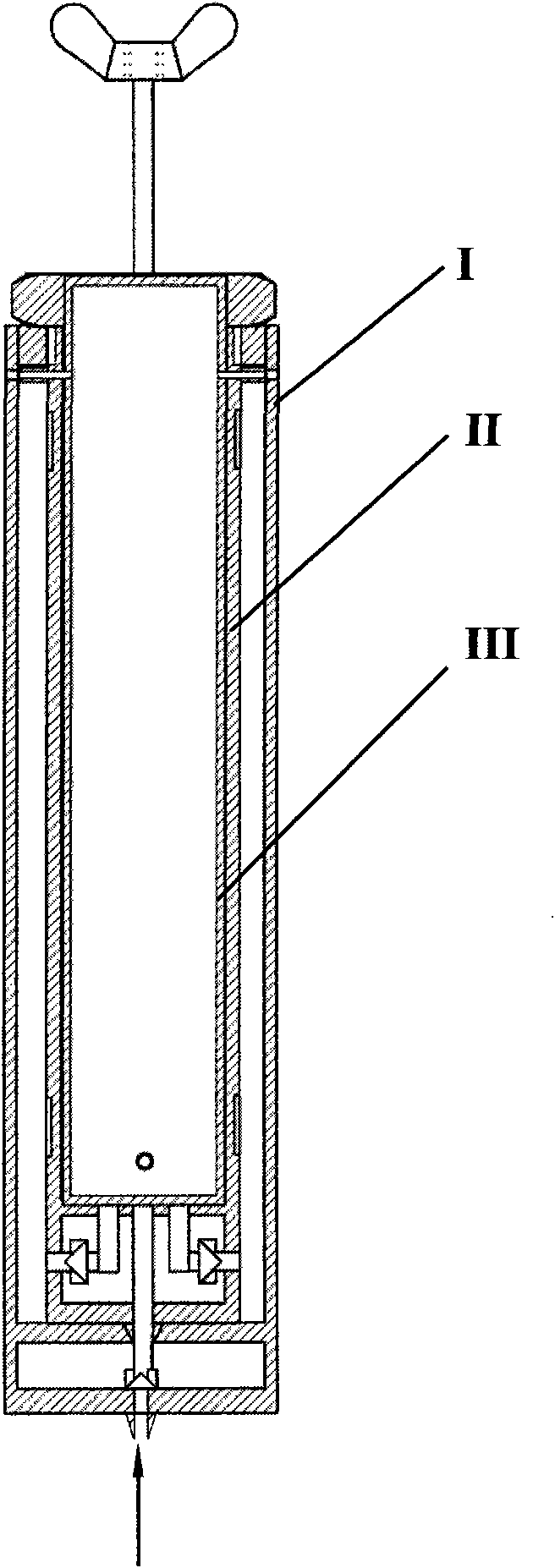Rapid sampler of micro polycyclic aromatic hydrocarbon in water based on electrospinning nano-fiber membrane
A technology of nanofiber membranes and polycyclic aromatic hydrocarbons, which is applied in the environmental monitoring of micro-polluted water sources and in the field of laboratory research. It can solve the problems of complicated enrichment and extraction of trace organic matter in water, inability to realize in-situ treatment of water samples, and high processing costs. Achieve the effects of easy control of sampling frequency, simple structure and strong adsorption capacity
- Summary
- Abstract
- Description
- Claims
- Application Information
AI Technical Summary
Problems solved by technology
Method used
Image
Examples
Embodiment 1
[0036]Sampling and analysis of simulated water samples (containing 1 μg / L fluorene, 1 μg / L phenanthrene, 1 μg / L anthracene, 1 μg / L fluoranthene, and 1 μg / L pyrene) were performed using a polycyclic aromatic hydrocarbon adsorption sampler. The sampling volume is 1000 ml, and the water sample is reciprocated for 8 times, each time the water sample stays in the water collection sleeve for 5 minutes and shakes slightly. After sampling, desorb with 50 ml of methanol for 3 minutes. As determined by high-performance liquid chromatography (DIONEX U3000, USA), the recoveries of five polycyclic aromatic hydrocarbons by this method are: 86.4% for fluorene, 90.4% for phenanthrene, 89.5% for anthracene, 87.8% for fluoranthene, and 87.8% for pyrene.
Embodiment 2
[0038] Sampling and analysis of simulated water samples (containing fluorene 2 micrograms / liter, phenanthrene 2 micrograms / liter, anthracene 2 micrograms / liter, fluoranthene 2 micrograms / liter, pyrene 2 micrograms / liter) were carried out using a polycyclic aromatic hydrocarbon adsorption sampler. The sampling volume is 500 ml, and the water sample is reciprocated for 4 times, each time the water sample stays in the water collection sleeve for 5 minutes and shakes slightly. After sampling, desorb with 50 ml of methanol for 3 minutes. As determined by high-performance liquid chromatography, the recovery rates of five polycyclic aromatic hydrocarbons by this method are: 85.6% for fluorene, 90% for phenanthrene, 88.9% for anthracene, 84.2% for fluoranthene, and 88.9% for pyrene.
Embodiment 3
[0040] Sampling and analysis of simulated water samples (containing fluorene 3 micrograms / liter, phenanthrene 3 micrograms / liter, anthracene 3 micrograms / liter, fluoranthene 3 micrograms / liter, pyrene 3 micrograms / liter) were performed using a polycyclic aromatic hydrocarbon adsorption sampler. The sampling volume is 2000 ml, and the water sample is reciprocated for 15 times, each time the water sample stays in the water collection sleeve for 5 minutes and shakes slightly. After sampling, desorb with 50 ml of methanol for 3 minutes. As determined by high-performance liquid chromatography, the recovery rates of five polycyclic aromatic hydrocarbons by this method are: 82.1% for fluorene, 84.8% for phenanthrene, 83.5% for anthracene, 88.7% for fluoranthene, and 87.5% for pyrene.
PUM
| Property | Measurement | Unit |
|---|---|---|
| diameter | aaaaa | aaaaa |
| thickness | aaaaa | aaaaa |
| diameter | aaaaa | aaaaa |
Abstract
Description
Claims
Application Information
 Login to View More
Login to View More - Generate Ideas
- Intellectual Property
- Life Sciences
- Materials
- Tech Scout
- Unparalleled Data Quality
- Higher Quality Content
- 60% Fewer Hallucinations
Browse by: Latest US Patents, China's latest patents, Technical Efficacy Thesaurus, Application Domain, Technology Topic, Popular Technical Reports.
© 2025 PatSnap. All rights reserved.Legal|Privacy policy|Modern Slavery Act Transparency Statement|Sitemap|About US| Contact US: help@patsnap.com



